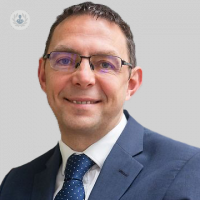Heart health: TAVI vs. AVR – Part 2
Autore:When aortic stenosis threatens the heart, two treatment options are TAVI and AVR. In the second part of this article, top cardiothoracic surgeon Mr Neil Roberts lays out the advantages and disadvantages of these procedures and explains when each would be recommended.

What are the benefits and risks of TAVI?
TAVI is much less invasive than an open heart operation; it only involves a tube being placed into the artery in the leg, and can be done under sedation rather than a full general anaesthetic. There is no doubt that if a TAVI goes well, the recovery period is much quicker than a surgical AVR.
However, being less invasive doesn’t necessarily mean less risky. The method of placing the valve backwards through the blood vessels, and then blowing up a high pressure balloon in a calcified and very stiff aortic valve is not without risk. There is also a chance that the valve won’t deploy into a perfect circle (the balloon inflation can be unpredictable) and if that happens it is possible the implanted valve may leak around the outside. We are also not sure how long valves implanted this way will last, as the initial technology was developed in elderly patients and who passed away due to other causes before the longevity of the TAVI valve could be properly tested.
The method of squashing the valve (crimping) onto the balloon to allow it to be small enough to pass through the blood vessels backwards might have effects on the ability of the valve to last as long as a surgical valve. This is not yet known. Just like with an open heart operation, there is a risk of stroke or even death during a TAVI procedure. There is also the risk of needing a permanent pacemaker.
The risks of TAVI have reduced over the years with the development of new techniques and technology, as has surgical aortic valve replacement.
What are the benefits and risks of AVR?
The risks of surgical AVR are similar to TAVI, in that there is a risk of mortality or having a stroke during the procedure, and a risk of needing a pacemaker. The risks of these events are calculated depending on the age and other medical problems of the patient.
With a surgical operation, there are also the risks associated with the incisions and healing from those incisions. We estimate that the total risk package for surgical aortic valve replacement in an otherwise healthy patient with aortic stenosis is approximately 1%.
There have been no trials of TAVI vs. surgery in young (less than 75-year-old patients) and as the risk of surgery is very low in younger patients, and the results of surgical aortic valve replacement are so good in the longer term, surgical aortic valve replacement remains the preferred treatment choice for those patients who are below 75 years old and have no other medical problems.
How do I know which procedure is the correct choice for me?
Your doctors will discuss your case at a heart team meeting, where many surgeons and cardiology doctors will review the details of an individual patient’s situation and make a recommendation. It is likely that over the age of 85, the recommended treatment will be TAVI, whereas if the patient is below 75 years of age and in good health, then it is likely surgery will be recommended, based on the data available and the European guidelines for treating aortic valve disease.
Between 75 and 85 years of age, the individual circumstances of the patient, and the data about the heart condition will help inform the recommendations. We await the results of the UK TAVI trial, which looked at these patients between 75 and 85 and when this data becomes available this will also help us inform patients and give recommendations.
Some surgeons are trained in both procedures, and are well placed to provide a consultation to discuss the options in more detail and tailor the discussion to the individual patient.
The important things to remember are that minimal access doesn’t mean less risk, but can mean a quicker recovery if all goes well, and that the heart team will give a recommendation of treatment after a multidisciplinary meeting, but patients are very free to ask about all other options when they are in a consultation to discuss their procedure.
Finally, the most important thing about severe symptomatic aortic stenosis is to have it treated, as the risks of leaving it alone are far higher than the risks of having a new aortic valve sited. The treatment of aortic stenosis has changed dramatically over the last 10-15 years, and that means that patients who previously couldn’t be treated now have the chance of life saving treatment.


